#i conlang
Text
I couldn’t take seeing that post an eighth time so I fixed it
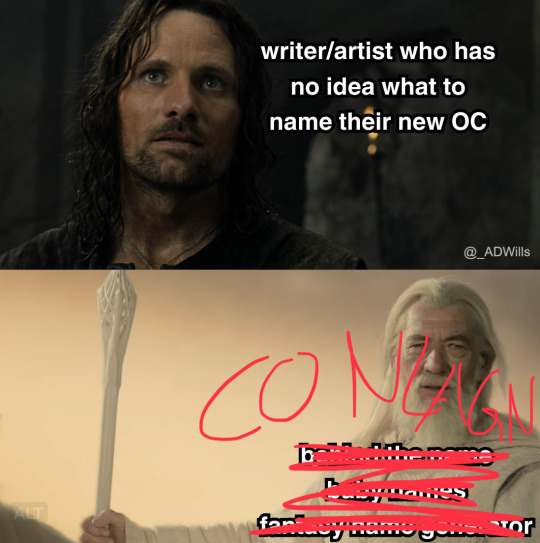
343 notes
·
View notes
Text
As much as I adore conlangs, I really like how the Imperial Radch books handle language. The book is entirely in English but you're constantly aware that you're reading a "translation," both of the Radchaai language Breq speaks as default, and also the various other languages she encounters. We don't hear the words but we hear her fretting about terms of address (the beloathed gendering on Nilt) and concepts that do or don't translate (Awn switching out of Radchaai when she needs a language where "citizen," "civilized," and "Radchaai person" aren't all the same word) and noting people's registers and accents. The snatches of lyrics we hear don't scan or rhyme--even, and this is what sells it to me, the real-world songs with English lyrics, which get the same "literal translation" style as everything else--because we aren't hearing the actual words, we're hearing Breq's understanding of what they mean. I think it's a cool way to acknowledge linguistic complexity and some of the difficulties of multilingual/multicultural communication, which of course becomes a larger theme when we get to the plot with the Presgar Translators.
#imperial radch#also a great example of the 'you don't have to be Tolkien' phenomenon#if you want to think about linguistic differences by building all the languages in your setting#and being able to explain what those differences are through actual texts in the language in question#that's AWESOME#but it's not the only way to do it#it's also interesting because of course this style only works in book form#everyone's speaking different languages but in a written account they're all 'translated' for you#but of course if it was a TV series they would all have to be speaking a language the audience understands#(or you *would* have to go wild with conlangs)#and i think that's really cool as well--#how for a series where song is so central we don't actually hear any of the actual in-universe words or any of the music#it's all been filtered#and again you know this is happening but seeing the examples of how real songs--the shape hymns and 'L'homme Arme'--are presented#makes you a lot more viscerally aware of how limited your perspective is#it's good#ann leckie i love you
2K notes
·
View notes
Photo

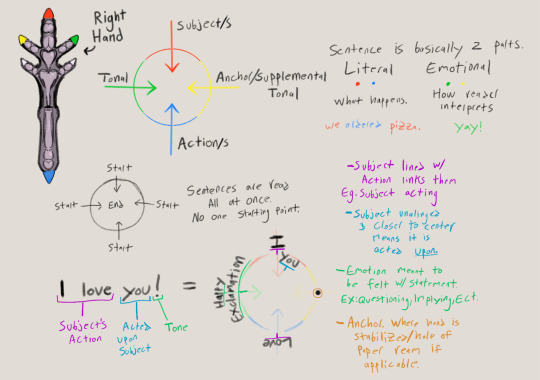
Wanted to figure out how chimera’s wrote and ended up starting on their written language proper. MASSIVE info dump below!
Writing
They write using four fingers of one hand, usually the right, coated in ink. Think like a stamp almost. The three middle fingers draw with the tips of the teeth whilst the thumb will alternate between tip and back. All words are written simultaneously inward. The remaining fingers grip the source of ink, usually a length of hardened pigment only wetted on one side OR those who write often could invest in a pen. A pen for a chimera is a fanning brush saturated with ink that the writing teeth brush through when needing to reink. It allows for much faster wetting of the teeth, but can be messy when learning or refilling.
Most chimera are right handed but left handed individuals exist, they will simply need to learn to use the two fingers opposite the middle in reverse of how someone who is right handed would! Luckily all fingers can move pretty independently of each other and it is an easy task. As chimera mostly communicate through direct broadcast most find the written word lacking, so it is a common occupation among Chimera to write for others. It is an impressive skill to eloquently convey ideas/feelings through writing. Though their language set up lends to it MUCH more than others.
The Nitty Gritty
All subject to change as this is very first drafty.
Chimeric is a logographic language, there is no set alphabet and all ‘words’ stem from symbols representing things and ideas. Sentences are kind of two sentences atop one another, with one being the literal and the other the reactionary. It is read from out to in and sentences are written in a circle divided into 4 quarters. We’ll start with the top moving counter clockwise.
Quarter 1 (Red) is the subject area, now subjects function the same as nouns for the most part, people, places, and things. But something important to note is that there must always be an ‘audience’ for the words being spoken. An audience basically means pronouns though they are a lot more encompassing with: I, You, Us, Them, Them excluding me/you, Us excluding you, Everyone, and a bunch of others. These are all acceptable audience subjects to top off your sentence. For instance you wouldn’t say “This pizza tastes good!” you would instead say “I enjoy the taste of this pizza” or “Everyone enjoys the taste of this pizza” the opinion/emotion needs to be applied to a source to make sense grammatically.
Quarter 2 (Green) is all about emotions and opinions. Chimeric language is an exchange of ideas but also importantly emotions and feelings. Q2 is dedicated to how the sentence is supposed to be interpreted or felt by the reader, as obviously in ‘spoken’ chimeric speaker and listener technically feel the same about what is currently being said. Listener opinion is very distinct from speaker and in writing the speaker takes priority. So for example the statement “Who finished the box but left it in the pantry?” would instead have to be translated into something akin to “I am pissed and questioning who had the audacity to finish the box and did not care enough to remove it from the pantry thus leaving me to find it and become disappointed?” Basically chimeric lends itself to very long translations due to their feelings.
Quarter 3 (Blue) is the action section of the sentence. The verbs if you will. This is where things are happening and is VERY tied in with Q1. Subjects in Q1 and Q2 will be linked together with lines that follow the same slice through the circle.
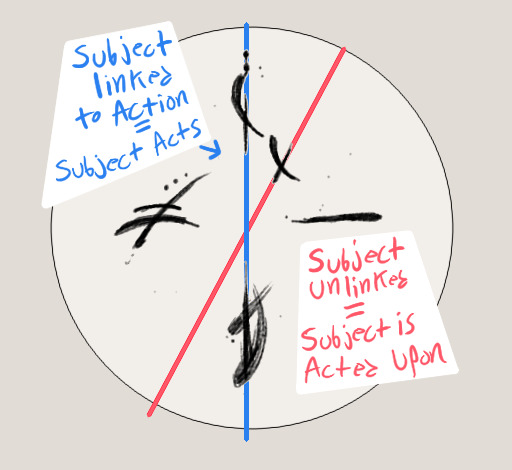
When a subject is linked to an action that means that the subject is the one performing the action, whereas subjects closer to the center and unaligned with an action are what is being acted upon. Like with the audience conundrum though an action needs a subject to actually act, whether it is an individual/s or an object or place. This is usually the least word heavy portion of the sentence as it is almost supplemental to Q1, and in contrast to the thin, crisp lines of the other quarters, Q3 will often be smudgey and more messy due to being written mostly with the back of the thumb.
Quarter 4 (Yellow) is generally not going to have any words written there, as it functions as the anchor point for the hand. The outmost finger rests here on the page to stabilize the hand as it closes during writing. When writing in a ream of papers this is where the hole to hold them all together is punched through. However in modern fanciful writing styles Q4 is also used as a secondary emotional quarter. This style will use Q4 as the reactionary emotion of the reader, more so the expected reaction and emotion from the reader. This is an EXTREMELY class based writing style and it is a GIANT NO NO to write like this for someone of higher status to read. Typically only Clan heads will freely use this writing style, especially towards each other lmao. The writing style of the passive aggressive power struggle.
All together Quarters are read at once! And I mean that there is no one word the chimera will start with. Every word of the sentence is absorbed at the same time, no following along a line like how I’m currently typing. But what indicates the order of which things are meant to be perceived is how close they are to the outside of the circle. Things closer to the center come later in the sentence and will be understood to be lower in the hierarchy of words. However only subjects and actions are directly linked to each other, emotion/opinion words are to have a more natural seep throughout the entirety of the sentence with only a loose idea of where they are to be felt. In this way while a subjects actions may be concrete, the writers feelings about them are more fluid and organic.
Chimeric conlang yay! I wanted to make modern Mirum script but decided I needed to start at the roots. So technically two written languages originate from Mirum, but they are extremely similar with one directly branching from the other. Chimeric is the original and Miran is the derivative, they mostly share characters but their sentence structure is different. Chimeric keeps the circular structure whereas Miran is a zigzagging horizontal and completely drops quarters 2 and 4. Leading to modern Miran being a very literal language vs Chimeric’s emotion heavy focus. But if you know one you can pretty much read the other, albeit with some culture shock.
#now i just have to make all the symbols hahaaha#chimera#mirum#conlang#worldbuilding#fantasy#language#chimeric#art#text#no true north
2K notes
·
View notes
Text
RJ asked: Hi there Idrisah!! Are there any interesting linguistic features of Tiiliitian and/or similarities between it and human languages?
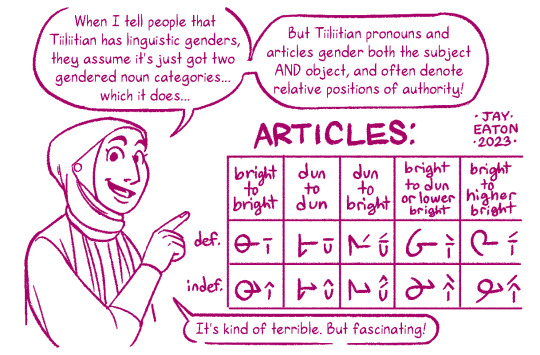
The relative positions of authority mostly applies to proper nouns, like people, nations, cities, and organizations. You could start a war by using the wrong tone in your articles.
#I need to overhaul this conlang but this bit probably won't change much#idrisah#comic#jayart#runaway to the stars#character ama
1K notes
·
View notes
Text

#linguistics#conlangs#languages#langblr#mymemes#this is how i feel when talking to my mom about what ''kay(f)bop(t)'' is and why it's funny
830 notes
·
View notes
Text
thoughts about the Cardassian writing system
I've thinking about the Cardassian script as shown on screen and in beta canon and such and like. Is it just me or would it be very difficult to write by hand?? Like.

I traced some of this image for a recent drawing I did and like. The varying line thicknesses?? The little rectangular holes?? It's not at all intuitive to write by hand. Even if you imagine, like, a different writing implement—I suppose a chisel-tip pen would work better—it still seems like it wasn't meant to be handwritten. Which has a few possible explanations.
Like, maybe it's just a fancy font for computers, and handwritten text looks a little different. Times New Roman isn't very easily written by hand either, right? Maybe the line thickness differences are just decorative, and it's totally possible to convey the same orthographic information with the two line thicknesses of a chisel-tip pen, or with no variation in line thickness at all.
A more interesting explanation, though, and the one I thought of first, is that this writing system was never designed to be handwritten. This is a writing system developed in Cardassia's digital age. Maybe the original Cardassian script didn’t digitize well, so they invented a new one specifically for digital use? Like, when they invented coding, they realized that their writing system didn’t work very well for that purpose. I know next to nothing about coding, but I cannot imagine doing it using Chinese characters. So maybe they came up with a new writing system that worked well for that purpose, and when computer use became widespread, they stuck with it.
Or maybe the script was invented for political reasons! Maybe Cardassia was already fairly technologically advanced when the Cardassian Union was formed, and, to reinforce a cohesive national identity, they developed a new standardized national writing system. Like, y'know, the First Emperor of Qin standardizing hanzi when he unified China, or that Korean king inventing hangul. Except that at this point in Cardassian history, all official records were digital and typing was a lot more common than handwriting, so the new script was designed to be typed and not written. Of course, this reform would be slower to reach the more rural parts of Cardassia, and even in a technologically advanced society, there are people who don't have access to that technology. But I imagine the government would be big on infrastructure and education, and would make sure all good Cardassian citizens become literate. And old regional scripts would stop being taught in schools and be phased out of digital use and all the kids would grow up learning the digital script.
Which is good for the totalitarian government! Imagine you can only write digitally. On computers. That the government can monitor. If you, like, write a physical letter and send it to someone, then it's possible for the contents to stay totally private. But if you send an email, it can be very easily intercepted. Especially if the government is controlling which computers can be manufactured and sold, and what software is in widespread use, etc.
AND. Historical documents are now only readable for scholars. Remember that Korean king that invented hangul? Before him, Korea used to use Chinese characters too. And don't get me wrong, hangul is a genius writing system! It fits the Korean language so much better than Chinese characters did! It increased literacy at incredible rates! But by switching writing systems, they broke that historical link. The average literate Chinese person can read texts that are thousands of years old. The average literate Korean person can't. They'd have to specifically study that field, learn a whole new writing system. So with the new generation of Cardassian youths unable to read historical texts, it's much easier for the government to revise history. The primary source documents are in a script that most people can't read. You just trust the translation they teach you in school. In ASIT it's literally a crucial plot point that the Cardassian government revised history! Wouldn't it make it soooo much easier for them if only very few people can actually read the historical accounts of what happened.
I guess I am thinking of this like Chinese characters. Like, all the different Chinese "dialects" being written with hanzi, even though otherwise they could barely be considered the same language. And even non-Sinitic languages that historically adopted hanzi, like Japanese and Korean and Vietnamese. Which worked because hanzi is a logography—it encodes meaning, not sound, so the same word in different languages can be written the same. It didn’t work well! Nowadays, Japanese has made significant modifications and Korean has invented a new writing system entirely and Vietnamese has adapted a different foreign writing system, because while hanzi could write their languages, it didn’t do a very good job at it. But the Cardassian government probably cares more about assimilation and national unity than making things easier for speakers of minority languages. So, Cardassia used to have different cultures with different languages, like the Hebitians, and maybe instead of the Union forcing everyone to start speaking the same language, they just made everyone use the same writing system. Though that does seem less likely than them enforcing a standard language like the Federation does. Maybe they enforce a standard language, and invent the new writing system to increase literacy for people who are newly learning it.
And I can imagine it being a kind of purely digital language for some people? Like if you’re living on a colonized planet lightyears away from Cardassia Prime and you never have to speak Cardassian, but your computer’s interface is in Cardassian and if you go online then everyone there uses Cardassian. Like people irl who participate in the anglophone internet but don’t really use English in person because they don’t live in an anglophone country. Except if English were a logographic writing system that you could use to write your own language. And you can’t handwrite it, if for whatever reason you wanted to. Almost a similar idea to a liturgical language? Like, it’s only used in specific contexts and not really in daily life. In daily life you’d still speak your own language, and maybe even handwrite it when needed. I think old writing systems would survive even closer to the imperial core (does it make sense to call it that?), though the government would discourage it. I imagine there’d be a revival movement after the Fire, not only because of the cultural shift away from the old totalitarian Cardassia, but because people realize the importance of having a written communication system that doesn’t rely on everyone having a padd and electricity and wifi.
#if I read over this again I will inevitably want to change and add things so I'm refraining from doing that. enjoy whatever this is#forgive my very crude recounting of chinese and korean history! I am neither a historian nor a linguist#but I will NOT apologize for talking abt china so much. that's my culture and I'm weird abt it bc of my family history#and it's my GOD GIVEN RIGHT to project what little I know abt it onto all my worldbuilding#also I've never actually read abt any of the various cardassian conlangs but I'm curious if this contradicts or coincides with any of them#I still want to make my own someday. starting college as a linguistics major (in 2 weeks!!) so presumably I will learn how to do that#narcissus's echoes#ds9#asit#star trek#cardassians#cardassian meta#a stitch in time#hebitians
679 notes
·
View notes
Text
Conlanging for cheaters
quick tips for creating fantasy language(s) that look believable if you squint
Pick a few rules about what letter/sound combinations can and cannot exist (or are common/uncommon). For example, in English, "sp" or "st" can begin a word, but in Spanish they can't. The "ng" sound (or the voiced velar nasal if you want to get technical), can't appear at the beginning of a syllable in English, but it can in at least of third of languages around the world. English allows for consonant clusters (more than one consonant together without a vowel), but some languages, such as Hawaiian, don't. Picking a few distinctive rules that are different from English or the language you are writing in, and sticking to them, will yield a lot better results than just keysmashing.
Assign meaning to a few suffixes, prefixes, or roots. A simple and useful example of this is making up a particle that means -land or -city or -town, and tacking it onto your appropriate place names. You could also have a particle with a similar meaning to the "er/or one we have in English, such as in "baker," "singer," or "operator," and then incorporate it in your fantasy titles or professions. It's like an Easter egg for careful readers to figure out, and it will make your language/world feel more cohesive.
Focus on places and names. You usually don't need to write full sentences/paragraphs in your conlang. What you might want to do with it is name things. The flavor of your language will seep in from the background, with the added benefit of giving readers some hints on background lore. For example, you could have a conlang that corresponds to a certain group of people, and a character with a corresponding name could then be coded as being from that group without having to specify. A human-inhabited city with an elven-sounding name might imply that it was previously inhabited by elves.
You don't have to know what everything means. Unless you are Linguistics Georg R. R. Tolkien, you probably don't want to (and shouldn't!) actually make up a whole language. So stick some letters together (following your linguistic rules, of course) and save fretting over grammar and definitions for the important stuff.
(Bonus) This isn't technically conlanging, but it can be fun to make up an idiom or two for your fantasy culture (just in English or whatevs) and sprinkle that in a few times. The right made-up idiom can allude to much larger cultural elements without you having to actually explain it.
Congrats! You now have a conlang you can dust over your wip like an appropriate amount of glitter. Conlangs can be intimidating, just because there's so much you can do, but that doesn't mean you have to do it all. So yeah anyway here's what I would recommend; hope y'all have fun :D
#writing advice#worldbuilding#conlanging#world building#fantasy#writeblr#writing#linguistics#I feel like sometimes it can be hard to know where to start#So I am telling you where to start
8K notes
·
View notes
Text
HI HELLO! Welcome to my completely unnecessarily detailed analysis on how I think Inkfish languages could work! + with art! yay! This is all pretty rough and not fully fleshed out (I don't have the time or patience for that lmao). THIS IS A LONG POST.
Okay, so there's dozens of languages spoken by cephalopods in the Mollusc Era but the main two I'll talk about are Inkling (or Inklish) and Octarian, spoken mostly by Inklings and Octolings respectively.
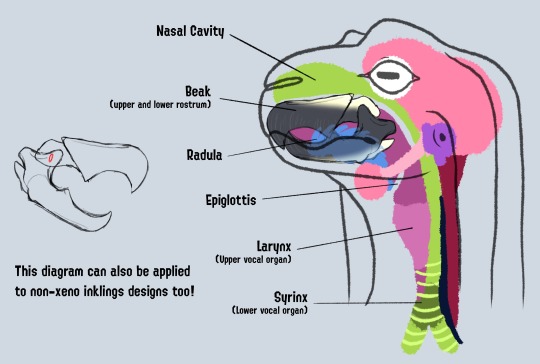
In cephalopods, speech is formed using the syrinx and larynx, two fancy vocal organs that most other species don't have together. The larynx makes sounds using the radula (tongue) and vocal folds in the throat, it's clear and pretty easy to understand as the sound itself resembles human speech, albeit warbled. The syrinx makes noise by vibrating air at the base of the trachea, it's often trickier to follow as it can sound more like droning background noise than words sometimes.
An inkfish can use both of them at once, resulting in an EXTREMELY complicated language system where words can be made up of multiple layered syllables, and several words and sentences can even be said at the same time.
As you can probably imagine, all of this is LITERAL HELL to learn for species who don’t have both a syrinx and a larynx (so basically anyone who isn't a cephalopod). But fear not! There are many simple and more inclusive alternatives, dialects and other cool stuff like sign language and instant TTS technology for people who physically can't pronounce Inkling/Octarian or even vocalise at all (eg. jellyfish).
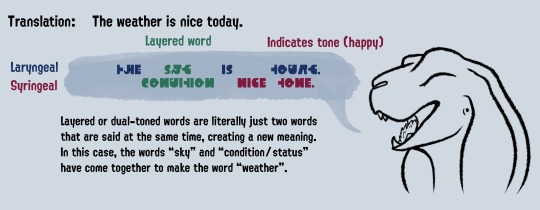
Both main Inkfish languages can be broken down into laryngeal words (made with the larynx), syringeal/drone words (made with the syrinx) or a combination of both, called dual-toned/layered words.
Keep in mind that both word-types can be spoken at the same time. Layering can be used to add additional connotations to a word, or to even make a new one entirely. For example, the laryngeal noun ‘bird’ combined with the syringeal noun ‘metal’ spoken together will create the layered Inkling word ‘aeroplane’, like a compound word in English.
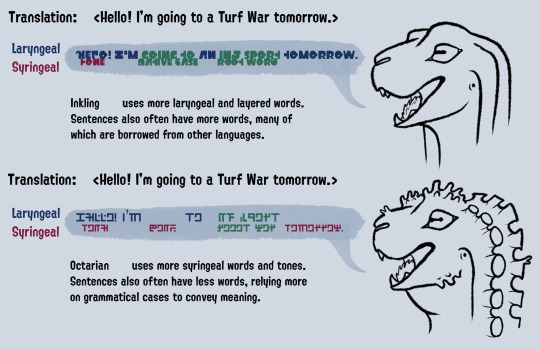
Dual-toned stuff is more common in Inkling than in Octarian, as the language is older and has more loanwords. Inklish's dependence on the larynx gives it a higher-pitched, clearer sound whereas Octarian's more monotone syrinx-based structure results in a deep, almost guttural sound.
Both cephalopod languages are heavy on tone and pronunciation, resulting in a plenty of accent indicators in written scripts. I used the in-game fonts for the art but if I were to rework it, each letter would probably be more complicated than traditional Mandarin on steroids. So hell on earth, basically.
On a side note, all of these language features open possibilities for some very cool poetry and literature. An inkfish author could write a poem with two lines of thought occurring at once, or a book with vivid emotional undertones written inside the prose. Pretty cool.
OKAY that's all I have to say thank you for reading! Hopefully this makes sense, feel free to send asks or whatever if it's confusing and I'll do my best to explain it better!
#I should go outside instead of analysing the silly squid game#I tried my best with my scientific and (limited) linguistic knowledge don't yell at me if I get something wrong lmao#my art#splatoon#xeno tag#xeno inkling#xeno octoling#splatoon 3#splatoon art#speculative biology#speculative zoology#conlang#splatoon headcanon#inkling#octoling#splatoon theory
571 notes
·
View notes
Photo

#lol#valar morghulis#valar dohaeris#Hello My Baby#A Song of Ice and Fire#ASOIAF#Game of Thrones#GoT#House of the Dragon#HotD#High Valyrian#conlangs#funny#I was looking up Reddit threads with people talking about the DuoLingo High Valyrian course#and I came across this absolute gem#I cannot believe how well it scans#I will be singing this for _days_
1K notes
·
View notes
Text
OH PHIL BEING FULL ON INFODUMPING ABOUT LINGUISTICS THIS IS EVERYHING TO MEEEEEEE
#I LOVE THIS SHIT#I LEARNED LIKE A TINY AMOUNT I KNOW ABOUT LINGUISTICS BC I GOT OBSESSED WITH CONLANGS A WHILE BACK#YEAH CALL ME A LABIODENTAL FRICATIVE#dan and phil#phan
257 notes
·
View notes
Text
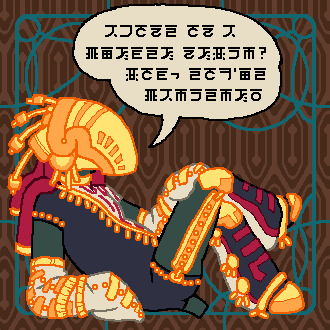
hmm it's friday right
#if i was slightly more insane i would have tried to conlang it a little but instead it's just random english letters assigned to glyphs lol#with a little bit of finagling to get it to fit#rain world#rain world oc#rw ancients#rain world ancients#fancharacters#my art#4 stars above countless pillars
736 notes
·
View notes
Text
Everytime The Witcher appropriates the welsh language but the has the GALL to mispronounce it, the power of my rage grows
do you know how seldom Welsh gets a fucking look in?! and the you have the gall to pronounce it like its fucking English
#the witcher#welsh#like i want to be excited because YAY WELSH#but then they do that#HE SAID SHAERRAWEDD 'Cher-Wed' i'm going to scream#its not even proper Welsh but if you're going to base your conlang that hard of an existing language i beg of you learn the rules#say it Shere-a-with#i'm going to start showing witcher colang to my nain to cause her psychic damage#i joke but tbh i think she would like that someone is taking the language she had stripped from her as a kid and is reviving it in a new wa#Anya at least says the first part right#to the point i suspect she studied and did her best but the directors fought her on the dd
597 notes
·
View notes
Text
I've spent an inordinate amount of time parsing the few examples we have of Old High Gallifreyan text, and here at last is the result of my labors!
The Old Gallifreyan alphabet:
The alternate forms of letters may be used interchangeably with their main forms; the differences are purely cosmetic, much like the difference between cursive and print-style writing.
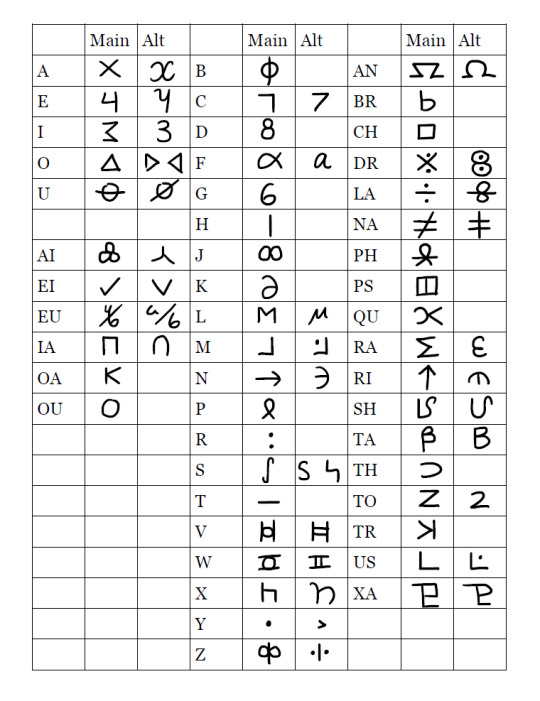
Now for my analysis of the existing texts. It's rather long, so I've put it below the break!
EXAMPLES OF OLD HIGH GALLIFREYAN TEXT
ITEM ONE

Supposedly from “The Five Doctors,” though I can’t spot this writing anywhere. Translation given in episode.

ORA PSYERPA
O – honorific indicating uniqueness, may be rendered with the definite article “the”
R – combined with the definite honorific, a common abbreviation of Rassilon’s name
A – an alternate version of the possessive “ya,” used only when the possessive noun is already abbreviated
Psyerpa – a general term for harps and other large stringed instruments
Thus, the full text reads:
O-Rassilon-ya psyerpa
The Rassilon’s harp
ITEM TWO

From “The Colony in Space,” across the bottom of the Doctor’s mugshot. No translation given.

QU ETHOA TRIOUAX BRIA
Qu – This is not a complete word, merely a letter used in this case for alphanumerical file designation: note that it stands alone, separate from the main text.
Ethoa – exile
Triouax – an infinitive verb, “to persist” or “to remain in effect”
Bria – a conditional modifier used exclusively in bureaucratic contexts, implying the need for occasional update of information or policy.
This text is a record of the Doctor’s sentence, and may be rendered something like this: Exile: to remain in effect barring further review.
ITEM THREE
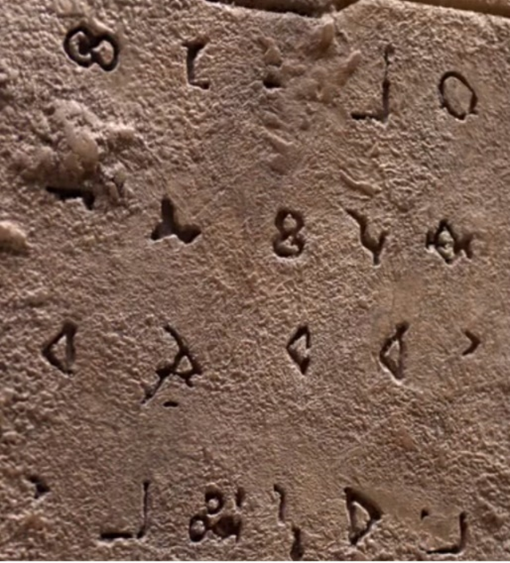
From “The Time of Angels.” Translation given.

JUSYMOU CAIDEU OXA OOYY MAISOM
Jusymou – An archaic greeting, roughly equivalent to “well met” or “hail.”
Caideu – self, soul, or “hearts” in a poetic sense
Oxa – prepositional suffix, “part of”
OOYY – a conceptual abbreviation that combines the two meanings of the solitary letter O (definite article + symbol of individuality) and the mathematical use of the letter Y (usually indicating a dimensional shift). Literally, this means something like the individual, shifted two dimensions. In practice, it refers to a Time Lord’s fifth dimensional aspect.
Maisom – name, designation, identification
Thus, a literal translation would read something like this: Greetings, soul-linked fifth-dimensional name!
Or as the Doctor paraphrases it: Hello, Sweetie.
ITEM FOUR
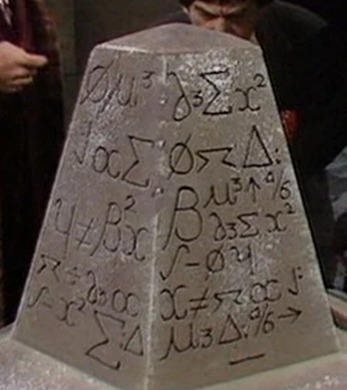
From “The Five Doctors.” Translation is given, though it’s not specified which face of the obelisk corresponds to which section of the text.
First Face:

RA NASA TO TANA EURIFSTAN OBLR ORE NATA
Ra – where
Nasa – sleep
To – in
Tana – lies, reclines, rests
Eurifstan – eternal, endless, timeless. Here it modifies the verb, so it should be rendered as an adverb.
Oblr – abbreviated form of obelar, tomb or grave
OR – the same abbreviation seen previously, “The One And Only Rassilon.”
E – an alternate version of the possessive “ya,” used only when the possessive noun is already abbreviated
Nata – a basic verb of being, is
This yields the following literal translation: Where sleep-in lies eternally, tomb Rassilon’s is.
Or as the Doctor translates it: This is the Tomb of Rassilon, where Rassilon lies in eternal sleep.
Second Face:
The text on the second face is never seen. The Doctor translates it as: Anyone who's got this far has passed many dangers and shown great courage and determination.
Third Face:

ULIREIF RAENATA TOAAN LAKI FSTA TORARO
Ulireif – to lose everything, to be utterly defeated
Raenata – an emphatic form of the being-verb nata, indicating that something really, truly, permanently is
Toa’an – to win everything, to be crowned victor
Laki – a compound conjunction combining la (so) with ki (and): “and so”
Fsta – an abbreviated form of festoa, a winner or leader
Toraro – future tense of torar, to fail or collapse
Thus: To lose all is truly to win all, and so the winner will fail.
Or as the Doctor puts it: To lose is to win, and he who wins shall lose.
Fourth Face:

KIRA ATOUNA OR TA LIRI EUKI RAATO SUTE ANAAN FEIRLIO REUNT
Kira – takes
Atouna – ring
OR – the same abbreviation seen previously, “The One And Only Rassilon.”
Ta – from
Liri – hand
Euki – a compound conjunction combining eu (then, next, afterward) with ki (and): “and then”
Ra’ato – future tense of ra’at, to wear
Sute – reward, prize, payment
Ana’an – desired, sought-after
Feirlio – future tense of feiril, to get or acquire. Note that this is an irregular verb: the last two letters switch places when adding any tense ending.
Reunt – immortality, eternity
Literally: Takes ring Rassilon-from-hand and then will wear, reward-sought will have: immortality.
Or as the Doctor translates it: Whoever takes the ring from Rassilon's hand and puts it on shall get the reward he seeks: immortality.
#doctor who#gallifreyan language#conlang#old high gallifreyan#no I have no idea how many hours I spent figuring this out#yes I'm working on figuring out the modern alphabet too (the one Four uses when he writes his letter at the beginning of Deadly Assassin)
227 notes
·
View notes
Text
Me, an hour into explaining the plot of the first third of CoH: and then he goes with this elf guy to this other elf guy, his name is Thingol-
My sibling, only paying a little attention: wait isn't that the guy who banned quinoa
#i'm crying about it gang its so funny#ah yes#my favorite conlang#quinoa#i love them theyre so funny sometimes#don't worry they ranted back at me#song being loud
220 notes
·
View notes
Text

The MODERN MIRAN SCRIPT. Basically the continuation of the old school Chimeric that I covered in this post. That has most of the nitty gritty and this is more so about the branch of the language. The BIG info dump below the cut!
Chimeric is the original, a purely written language used by chimera when talking is unavailable. Written in a circle heading inwards with two defined lines of dialogue. The subject/action 'real' substance and the tonal, emotional intent of the writer and sometimes reader. Chimeric is still used by the remaining population to talk within their ranks, but nearly every chimera is at least bilingual depending on where they ended up. Back in Mirum the written language of Chimeric stayed behind but has been pretty heavily modified to better suit the reading style of the people that remained. Mainly Histin who cut out pretty much all the fluff and added a bit more structure.
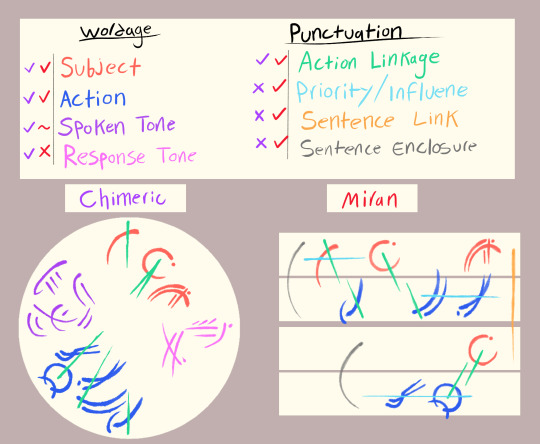
So! As opposed to the radial style of Chimeric, Miran has double decker sentences. With the top row being the remnants of the Subject quarter and the bottom row being the Action quarter. Linkage of subjects and actions take place between the two lines. Plus there is a new form of linkage, the priority/influence links which show which subject is acting upon who, and define action sequences.
While Chimeric is written inwards radially, Miran is written top to bottom, starting going from left to right then right to left and alternating down the page. Also circular paper is swapped for rectangular, think a standard 8x10. Still, you are expected to enclose sentences within two parentheses, lil hold over from the circular days. But to the outside perspective the largest difference between the two is their tones, or well overtonage of one and lack of tone in the other. Chimeric is the 3 paragraph overly detailed text, Miran is the single word response. Lest to say they do not mesh super well.

ANOTHER fun hold over I want to add but am still thinking over characters for is that for rare fancy words (poetry/music/heart speak) Miran can slide in a THIRD ROW in between the first and second. There the spoken tone quarter manages to eek out a meager Miran existence through a few dozen sets of characters to convey certain emotions and the like. Songs in Miran very often have multiple sets of lyrics overlaid in this fashion, the largest can have 5+ tonal rows.
Oh that reminds me! Miran DOES have a spoken equivalent. Or rather, the original shared Histin/Diagrevies language has been stretched over to fit better with the written word. That in itself has split the spoken word in Mirum in two once more, with spoken Miran and Draconic being the two main talkings. Histin typically only speak and read Miran, whilst Diagrevies will speak both; with their preference being draconic. A Diagrevies will typically have a Histin under their employ to read and write for them since ya know, they cannot see.

All this taken into consideration though, Miran and Chimeric are still basically two ways of writing the same basal language. Not that modern speakers like to admit that. But small character additions and style changes aside, if you can read one you can get the gist of the other. Miran is by far the most spoken in modern times tho. Its a little more accessible for different species than Chimeric.
Want to get more into the modern Mirum dealings. The chimera may be absent but their influence is still very plain to see if you know where to look.
#yay i missed drawin all these guys#chimera#histin#diagrevies#kinda#they dont get the writing unfortunately#no true north#worldbuilding#conlang#art#mirum
169 notes
·
View notes
Text
WAIT okay I don't know how to word this at all but basically the way we perceive speech sounds is through like. different frequencies are amplified or dampened by the ways we shape our vocal tract and we hear those differences in like which frequencies are louder and which frequencies are quieter and that's how we recognize different phonemes. or something. so if like aliens have a different hearing range and/or differently shaped vocal tracts they could have an entirely different phonemic inventory than human languages??? like shrimp colors but it's alien phonemes???? this might seem like a really obvious realization but like those guys could be distinguishing vowels based on formants we can't even perceive!! their hearing range could start above 5000 hz and they wouldn't be able to hear the difference between any of our vowels!! enough with giving klingon uvular plosives or whatever to make it sound ""exotic"" that shit should be UNPRODUCIBLE with a human vocal tract and UNPERCEIVABLE with human ears!! no wonder they need universal translators when your ears could be physically unable to distinguish between alien phonemes??? sorry I'm realizing that this really is an incredibly obvious thought just couched in overly technical language but I'm excited about it nonetheless. spock's surname is unpronounceable bc it's got a bunch of consonant clusters? NO it actually has secret vulcan phonemes distinguished by differences in frequencies above the human range of hearing so u can't even perceive it correctly let alone pronounce it. cardassians have a hearing range significantly smaller than humans so they physically cannot understand most human languages...
#shrimp colors alien phonemes.........#I. understand why we conlang within our physical limits as humans but it's a fun thought experiment idk#I love u phonetics 2 class.#narcissus's echoes
142 notes
·
View notes